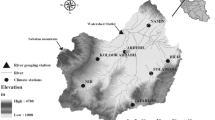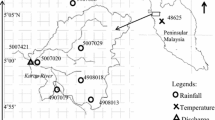Abstract
Climate projections for the Huaihe River Basin, China, for the years 2001–2100 are derived from the ECHAM5/MPI-OM model based on observed precipitation and temperature data covering 1964–2007. Streamflow for the Huaihe River under three emission scenarios (SRES-A2, A1B, B1) from 2010 to 2100 is then projected by applying artificial neural networks (ANN). The results show that annual streamflow will change significantly under the three scenarios from 2010 to 2100. The interannual fluctuations cover a significant increasing streamflow trend under the SRES-A2 scenario (2051–2085). The streamflow trend declines gradually under the SRES-A1B scenario (2024–2037), and shows no obvious trend under the SRES-B1 scenario. From 2010 to 2100, the correlation coefficient between the observed and modeled streamflow in SRES-A2 scenario is the best of the three scenarios. Combining SRES-A2 scenario of the ECHAM5 model and ANN might therefore be the best approach for assessing and projecting future water resources in the Huaihe basin and other catchments. Compared to the observed period of streamflows, the projected periodicity of streamflows shows significant changes under different emission scenarios. Under A2 scenario and A1B scenario, the period would delay to about 32–33a and 27–28a, respectively, but under B1 scenario, the period would not change, as it is about 5–6a and the observed period is about 7–8a. All this might affect drought/flood management, water supply and irrigation projects in the Huaihe River basin.










Similar content being viewed by others
References
Abrahart RJ, See L, Kneale PE (1999) Using pruning algorithms and genetic algorithms to optimize network architectures and forecasting inputs in a neural network rainfall-runoff model. J Hydroinformatics 1(2):103–114
Blender R, Fraedrich K (2006) Long-term memory of the hydrological cycle and river runoffs in China in a high-resolution climate model. Int J Climatol 26(12):1547–1565. doi:10.1002/joc.1325
Chang FJ, Chen YC (2001) A counterpropagation fuzzy-neural network modeling approach to real time streamflow prediction. J Hydrol 245:153–164. doi:10.1016/S0022-1694(01)00350-X
Clarke GKC, Berthier E, Schoof CG et al (2009) Neural networks applied to estimating subglacial topography and glacier volume. J Clim 22(8):2146–2160. doi:10.1175/2008JCLI2572.1
Cobaner M, Unal B, Kisi O (2009) Suspended sediment concentration estimation by an adaptive neuro-fuzzy and neural network approaches using hydro-meteorological data. J Hydrol 367:52–61. doi:10.1016/j.jhydrol.2008.12.024
Dawson CW, Harpham C, Wilby RL et al (2002) Evaluation of artificial neural network techniques for flow forecasting in the River Yangtze, China. Hydrol Earth Syst Sci 6:619–626
Ding YH, Ren GY, Shi GY et al (2006) National assessment report of climate change (i): climate change in China and its future trend. Adv Clim Change Res 2(1):3–8 in Chinese
Fu GB, Charles SP, Yu JJ et al (2009) Decadal climatic variability, trends, and future scenarios for the North China Plain. J Clim 22(8):2111–2123. doi:10.1175/2008JCLI2605.1
Gamage NKK (1990) Detection of coherent structures in shear induced turbulence using wavelet transform methods. American Mathematical Society Symposium on Turbulence and Diffusion. Roskilde, Danmark
Gao C, Zhai J, Tao H et al (2009) Hydrological response to land use/land cover change in Chaohu Basin (in Chinese). J Nat Resour 24(10):1–9
Gaucherel C (2002) Use of wavelet transform for temporal characterization of remote watersheds. J Hydrol 269:101–121. doi:10.1016/S0022-1694(02)00212-3
Gerstengarbe FW, Werner PC (1999) Estimation of the beginning and end of recurrent events within a climate regime. Clim Res 11:97–107. doi:10.3354/cr011097
Haan CT (2002) Statistical methods in hydrology (second version). Blackwell Publishing
Hsu K, Gupta HV, Sorooshian S (1995) Artificial neural network modeling of the rainfall-runoff process. Water Resour Res 31(10):2517–2530
Huang JC, Lee TY, Kao SJ (2009) Simulating typhoon-induced storm hydrographs in subtropical mountainous watershed: an integrated 3-layer TOPMODEL. Hydrol Earth Syst Sci 13:27–40
Inmaculada PC, Maria MP (2007) Application of neural approaches to one-step daily flow forecasting in Portuguese watersheds. J Hydrol 332:1–15. doi:10.1016/j.jhydrol.2006.06.015
IPCC (2007) Climate change 2007: synthesis report. http://www.ipcc.ch/ipccreports/index.htm
Jakeman AJ, Hornberger GM (1993) How much complexity is warranted in a rainfall-runoff model? Water Resour Res 29(8):2637–2649
Kendall MG (1975) Rank correlation methods. Griffin, London, UK
Kumar P, Foufoula-Geogiou E (1997) Wavelet analysis for geophysical applications. Rev Geophys 35(4):385–412. doi:10.1029/97RG00427
Labat D (2005) Recent advances in wavelet analyses: part 1. A review of concepts. J Hydrol 314:275–288. doi:10.1016/j.jhydrol.2005.04.003
Li J, Yu RC, Zhou TJ (2008) Seasonal variation of the diurnal cycle of rainfall in Southern Contiguous China. J Clim 21(22):6036–6043. doi:10.1175/2008JCLI2188.1
Li HX, Zhang YQ, Chiew FHS et al (2009) Predicting runoff in ungauged catchments by using Xinanjiang model with MODIS leaf area index. J Hydrol 370:155–162. doi:10.1016/j.jhydrol.2009.03.003
Liu CZ (1997) Potential impact of climate change on hydrology and water resources in China. Adv Water Sci 8(3):220–225 (in Chinese)
Lorrai M, Sechi GM (1995) Neural nets for modelling rainfallrunoff transformations. Water Resour Manage 9:299–313. doi:10.1007/BF00872489
Ma YX, Wang F (2008) Runoff’s character and its cause analysis in Huaihe River. J Chin Hydrol 28(1):77–81 (in Chinese)
Mann HB (1945) Nonparametric tests against trend. Econometrica 13:245–259
Marsland SJ, Haak H, Jungclaus JH et al (2003) The Max-Planck-Institute global ocean/sea ice model with orthogonal curvilinear coordinates. Ocean Model 5:91–127. doi:10.1016/S1463-5003(02)00015-X
McBean E, Motiee H (2008) Assessment of impact of climate change on water resources: a long term analysis of the Great Lakes of North America. Hydrol Earth Syst Sci 12:239–255
Mitchell JM, Dzerdzeevskii B, Flohn H et al (1966) Climate Change, WMO Technical Note No. 79, World Meteorological Organization, pp 79
Modarres R (2009) Multi-criteria validation of artificial neural network rainfall-runoff modeling. Hydrol Earth Syst Sci 13:411–421
Morlet J, Arens G, Fourfeau E et al (1982) Propagation and sampling theory 1: complex signal and scattering in multi-layered media. Geophysics 47(2):203–221
Moulin L, Gaume E, Obled C (2009) Uncertainties on mean areal precipitation: assessment and impact on streamflow simulations. Hydrol Earth Syst Sci 13:99–114
Princepe JC, Euliano NR, Lefebvre WC (1999) Neural and adaptive systems: fundamentals through simulations. Wiley, pp 122–149
Radziejewski M, Kundzewicz ZW (2004) Detectability of changes in hydrological records. J Hydrol Sci 49(1):39–51. doi:10.1623/hysj.49.1.39.54002
Roeckner E, Bauml G, Bonavetura L et al (2003) The atmospheric general circulation model ECHAM 5. PART I: Model description. MPI Report No.349. Max-Planck-Institute for Meteorology, Hamburg
Serrano VL, Mateos VL, Garci′a JA (1999) Trend analysis of monthly precipitation over the Iberian Peninsula for the period 1921–1995. Phys Chem Earth B 24(2):85–90. doi:10.1016/S1464-1909(98)00016-1
Shao Q, Li Z, Xu Z (2009) Trend detection in hydrological time series by segment regression with application to Shiyang River Basin. Stoch Environ Res Risk Assess. doi:10.1007/s00477-009-0312-4
Smith J, Eli RB (1995) Neural Network models of rainfall-runoff process. J Water Res Pl. ASCE. 121(6):499–508. doi 10.1061/(ASCE)0733-9496(1995)121:6(499)
Su B, Xiao B, Zhu D, Jiang T (2005) Trends in frequency of precipitation extremes in the Yangtze River basin, China: 1960–2003. J Hydrol Sci 50(3):479–492. doi:10.1623/hysj.50.3.479.65022
Tian H, Xu YL, Lin ED (2008) Climate change due to greenhouse effects in Changjiang-Huaihe River valley projected by a regional climate model. Adv Clim Change Res 4(6):357–362 (in Chinese)
Tokar AS, Johnson PA (1999) Rainfall-runoff modeling using artificial neural network. J Hydrol Eng 4:232–239
Torrence C, Compo GP (1998) A practical guide to wavelet analysis. Bull Am Meteorol Soc 79:61–78
UNDP (2006) Beyond scarcity: power, poverty and the global water crisis, Human Development Report 2006. UNDP
Von Storch VH (1995) Misuses of statistical analysis in climate research. In: Storch HV, Navarra A (eds) Analysis of climate variability: application of statistical techniques. Springer-Verlag, Berlin, pp 11–26
Wang YJ (2007) Multiple time dimensional analysis for annual run-off corollary of the Bengbu hydrographic station of mainstream of the Huaihe River. Tech superv water res 1:37–40 (in Chinese)
Wang WS, Ding J (2003) Wavelet network model and its application to the prediction of hydrology. Nat Sci 1(1):67–71
Wang MH, Xie Q, Wang HG (2003) Impact of future climate change on runoff depth of the Huaihe drainage basin. Geogr Res 22(1):79–88 (in Chinese)
Wang S, McGrath R et al (2006) The impact of the climate change on discharge of Suir River Catchment (Ireland) under different climate scenarios. Nat Hazards Earth Syst Sci 6:387–395
Webster M, Forest C, Reilly J et al (2003) Uncertainty analysis of climate change and policy response. Clim Change 61:295–320. doi:10.1023/B:CLIM.0000004564.09961.9f
Wu JD, Li N, Yang HJ et al (2008) Risk evaluation of heavy snow disasters using BP artificial neural network: the case of Xilingol in Inner Mongolia. Stoch Environ Res Risk Assess 22:719–725. doi:10.1007/s00477-007-0181-7
You WH (1998) Multiscale Diagnosis Analyses and Forecast Methods of Climate Changes (in Chinese). China Meteorological Press, Beijing, pp 9–20
Yue S, Pilon P (2004) A comparison of the power of the t test, Mann–Kendall and bootstrap for trend detection. J Hydrol Sci 49(1):21–37. doi:10.1623/hysj.49.1.21.53996
Yue S, Pilon P, Phinney B et al (2002) The influence of autocorrelation on the ability to detect trend in hydrological series. Hydrol Process 16:1807–1829. doi:10.1002/hyp.1095
Zhang LN, Wang BZ, Zeng QC (2009) Impact of the Madden–Julian oscillation on summer rainfall in Southeast China. J Clim 22(2):201–216. doi:10.1175/2008JCLI1959.1
Zhao P, Zhou ZJ, Liu JP (2007) Variability of Tibetan spring snow and its associations with the hemispheric extratropical circulation and East Asian summer monsoon rainfall: an observational investigation. J Clim 20(15):3942–3955. doi:10.1175/JCLI4205.1
Acknowledgements
The leading work for the preparation of this paper has been financially supported by the National Natural Science Foundation of China (project no. 40601017, 40771040, 40701028), and funds were received from the Anhui Province meteorological bureau (No. HRM200702) and the Natural Science Foundation of Anhui (090415212). The authors also thank the Max Planck Institute for Meteorology, Hamburg, Germany, which has provided the valuable ECHAM5/MPI-OM model. Discussions with Dr Chen Youmin of Max-Planck-Institute for Biogeochemistry (Germany) are also gratefully acknowledged. Dr Marco Gemmer is a Visiting Professor and integrated expert of CIM at the China Meteorological Administration, supported by the German Government through the CIM programme (www.cimonline.de).
Author information
Authors and Affiliations
Corresponding author
Rights and permissions
About this article
Cite this article
Gao, C., Gemmer, M., Zeng, X. et al. Projected streamflow in the Huaihe River Basin (2010–2100) using artificial neural network. Stoch Environ Res Risk Assess 24, 685–697 (2010). https://doi.org/10.1007/s00477-009-0355-6
Published:
Issue Date:
DOI: https://doi.org/10.1007/s00477-009-0355-6




